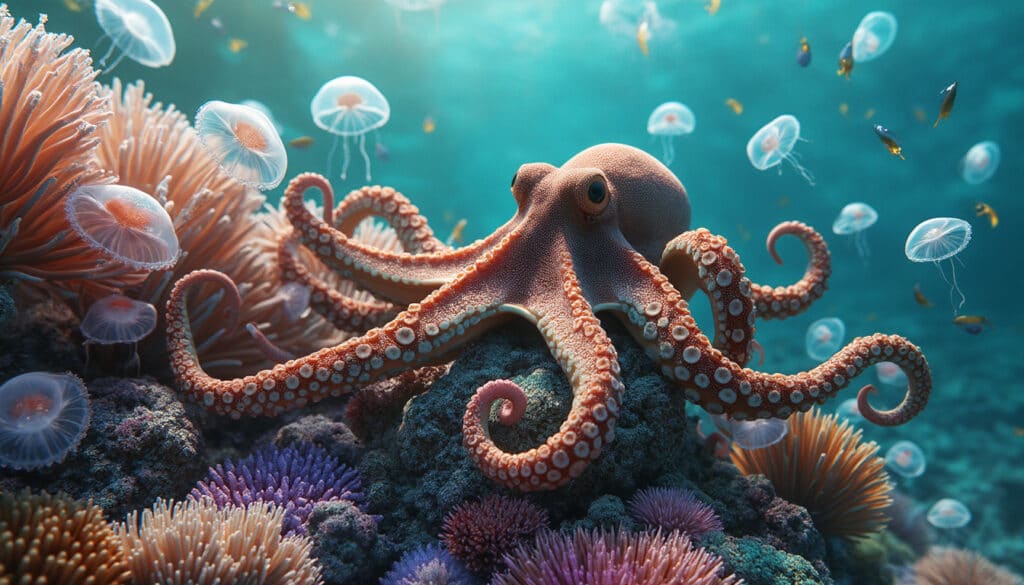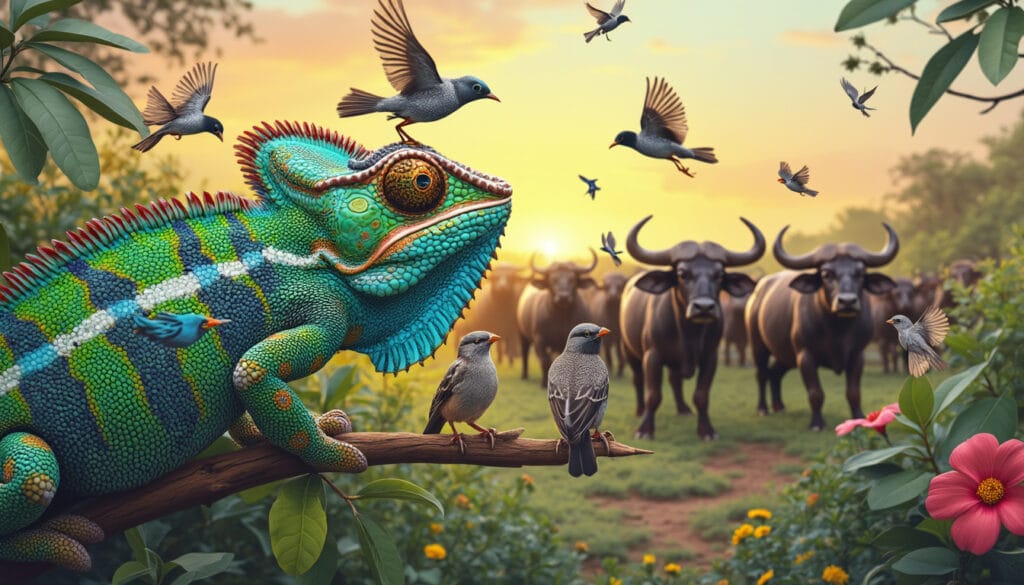Invertebrates dominate our planet, representing a stunning diversity. These creatures without a backbone play a crucial role in maintaining ecosystems. From the microscopic world of sponges to the majestic formations of mollusks, their variety is unmatched.
Invertebrates make up about 95% of known animal species, encompassing 34 distinct phyla. Their lack of an internal skeleton gives them remarkable flexibility, adapted to varied environments. These multicellular organisms are distinguished by the absence of notochord, unlike vertebrates. Their contribution is essential, particularly in biological cycles and water purification, illustrating their ecological importance.
What is an invertebrate?
Invertebrates represent an incredibly diverse group of animals, lacking a backbone. Unlike vertebrates such as mammals or birds, invertebrates do not have articulated internal bones. They encompass a wide range of species, from marine sponges to terrestrial insects, including mollusks and arthropods. These creatures are distinguished by their varied body structures and unique adaptations to different environments.
Invertebrates play a crucial role in many ecosystems. For example, marine sponges filter water, helping to maintain the clarity and quality of oceans. Insects, in turn, are essential for the pollination of plants and the decomposition of organic matter. With about 95 to 97% of known animal species belonging to this group, invertebrates represent an impressive majority of global biodiversity.
Exploring the world of invertebrates reveals fascinating and often unknown forms of life. Their lack of a backbone does not prevent them from developing complex mechanisms to survive and thrive in varied habitats, from ocean depths to arid deserts. This adaptability makes invertebrates exciting subjects of study for biologists and nature enthusiasts.
The diversity of invertebrates in the animal kingdom
The diversity of invertebrates is one of the most remarkable within the animal kingdom. With 34 different phyla, these creatures exhibit a variety of forms, sizes, and lifestyles that defy imagination. From tiny larvae to imposing jellyfish, each group of invertebrates possesses unique characteristics that set them apart from each other.
Mollusks, for example, include animals as diverse as snails, octopuses, and oysters. They are characterized by the presence of a muscular foot and, in some cases, a protective shell. Arthropods, such as insects, spiders, and crustaceans, have a rigid exoskeleton and jointed appendages, which allows for great mobility and a variety of behaviors.
Echinoderms, like starfish and sea urchins, exhibit radial symmetry and a remarkable ability to regenerate. Other groups, such as cnidarians (jellyfish, corals), possess stinging cells called cnidocytes, used for capturing prey and defense. This multiplicity of phyla illustrates not only the extent of invertebrate diversity but also their capacity to adapt to extremely varied environmental conditions.
The diversity of invertebrates is also a reflection of their long evolutionary history. Some groups have existed for hundreds of millions of years, demonstrating their resilience and ability to evolve in the face of climatic and geological changes. This biological richness makes invertebrates valuable indicators of ecosystem health and essential subjects for scientific research.
Why invertebrates are essential to our ecosystem
Invertebrates play indispensable roles in maintaining the balance of ecosystems. Their presence and activities directly influence the health of natural environments and, by extension, our own well-being. For instance, pollinating insects like bees and butterflies are crucial for the reproduction of many flowering plants, thereby ensuring food production and plant diversity.
Ladybugs and other predatory insects help control pest populations, thereby reducing the need to use chemical pesticides that can have harmful effects on the environment. Annellids, such as earthworms, play a key role in improving soil quality by facilitating the decomposition of organic matter and aerating the soil, which promotes plant growth.
In marine environments, melitophytes and other marine invertebrates contribute to the structure of coral reefs and the filtering of water, helping to maintain healthy and diverse aquatic habitats. Additionally, invertebrates serve as food for many other animals, forming the base of the complex food chains that support overall biodiversity.
In light of the increasing wastewater discharges into rivers, as illustrated by this study, invertebrates are particularly vulnerable. Water pollution can affect their habitats and disrupt their life cycles, leading to major ecological imbalances. Therefore, preserving invertebrates is essential to ensure the resilience of ecosystems in the face of environmental threats.
The most fascinating marine invertebrates
The oceans are teeming with extraordinary marine invertebrates, each possessing unique characteristics and behaviors. Among the most fascinating, corals stand as an emblematic example. These marine animals form massive colonies that build coral reefs, genuine underwater ecosystems housing a multitude of species.
Jellyfish, with their ethereal shapes and graceful movements, are also captivating marine invertebrates. Some species are bioluminescent, producing their own light through internal chemical reactions. This ability not only helps them defend themselves but also attracts prey in the ocean’s dark depths.
Octopuses and other cephalopods are known for their intelligence and ability to solve complex problems. Their flexible bodies and versatile tentacles allow them to slip into tight spaces and manipulate objects with remarkable skill. These traits make octopuses favored subjects of research in neuroscience and animal behavior.
Starfish and sea urchins play a crucial role in marine ecosystems by regulating algae growth and recycling nutrients. Their interactions with other marine species contribute to the complex dynamics of reefs and seabeds. Each marine invertebrate, by its very existence, contributes to the richness and diversity of aquatic habitats.
These marine creatures are not only fascinating for their appearance and behaviors but also for their ability to adapt to extreme environments. From dark, pressurized abysses to colorful coral reefs, marine invertebrates demonstrate incredible resilience and a variety of adaptations that testify to the complexity and beauty of underwater life.
How pollution affects invertebrates
Pollution is one of the most serious threats to invertebrates, both terrestrial and marine. Contamination of water, air, and soil by toxic substances can have devastating effects on these creatures crucial for ecological balance. Wastewater discharges, for example, increasing by 50% in rivers in 2024 according to this article, lead to a deterioration of water quality, making marine invertebrate habitats less hospitable and more dangerous.
Polluting chemicals, such as heavy metals and pesticides, can accumulate in the tissues of invertebrates, disrupting their reproduction, growth, and survival. For example, filter-feeding mollusks, such as oysters, are particularly vulnerable to water pollution as they constantly filter large amounts of water to feed. This directly exposes them to contaminants present in their environment.
Plastic pollution is also a major threat. Small pieces of plastic, known as microplastics, are ingested by many marine invertebrates, causing digestive blockages and chemical poisoning. Terrestrial invertebrates, like amphibians, are also affected by plastics in their habitat, compromising their health and reproduction.
Furthermore, ocean acidification, resulting from rising CO2 levels, alters the chemical conditions of the water and affects calcification in marine invertebrates such as corals and mollusks. This alteration can weaken their body structures and reduce their ability to protect themselves against predators and diseases.
In the face of these challenges, protecting invertebrates requires concerted actions to reduce pollution and restore degraded habitats. International efforts to limit wastewater discharges and reduce plastic use are essential to preserve these vital creatures and maintain the health of global ecosystems.
Which invertebrate fascinates you the most?
Everyone can find an invertebrate that fascinates them for different reasons, whether it be for their unique appearance, intriguing behaviors, or essential ecological roles. Let us explore some of the most captivating invertebrates that inspire awe among enthusiasts.
Butterflies are often loved for their colorful wings and varied patterns, symbolizing the beauty and fragility of nature. Their life cycle, transitioning from caterpillar to adult metamorphosis, is an impressive natural spectacle that illustrates the potential for transformation and renewal.
Spiders, although often feared, fascinate with their ability to weave complex webs. These ingenious structures not only capture prey but are also remarkable examples of natural ingenuity. Each type of spider has unique weaving techniques adapted to its specific environment.
Ants are another admired group of invertebrates for their social organization and efficiency. Ant colonies are examples of collective cooperation, with well-defined roles for each member, ranging from workers to queens. Their ability to construct complex nests and manage resources optimally is a source of inspiration for many researchers.
Scorpions, with their prehistoric appearance and impressive survival capabilities, also draw attention. Their hunting methodology and defense mechanisms, such as venomous stings, are fascinating aspects of their biology.
Finally, starfish and other marine invertebrates continue to captivate with their apparent simplicity and internal complexity. Their ability to regenerate and interact with their environment under extreme conditions shows remarkable resilience and adaptability.
Whatever your favorite invertebrate may be, it is undeniable that these creatures play a crucial role in maintaining our ecosystems and deserve increased attention and protection to preserve the rich biodiversity of our planet.
Articles similaires
Thank you!
We will contact you soon.














